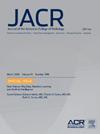2017年至2021年美国医疗保险B部分人群中与不适当医疗成像相关的过量温室气体排放
IF 4
3区 医学
Q1 RADIOLOGY, NUCLEAR MEDICINE & MEDICAL IMAGING
引用次数: 0
摘要
医学成像是温室气体排放的一个来源,不恰当的使用导致低价值、多余的成像。低价值成像对环境的影响尚未量化。目的:本研究旨在以公制千吨(kT)二氧化碳当量(CO2e)为单位估算2017年至2021年医疗保险B部分人口与不适当成像相关的过量温室气体(GHG)排放。材料和方法:利用Harvey L. Neiman健康政策研究所2017年至2021年关于医疗保险收费服务受益人成像利用趋势的数据和2014年兰德公司关于医疗保险成像示范的报告,对医疗保险B部分人群中不适当检查造成的平均年温室气体排放量的低端和高端估计进行了建模,包括四种最常见的成像方式(MRI, CT, x线摄影,每年不适当检查的估计数量和每种模式的温室气体排放量。结果:在所有的影像学检查中,估计有4%到26%是不合适的。在整个5年期间,估计不适当的医疗保险成像检查平均每年产生3.55至129.2 kT CO2e,其中MRI和CT所占比例最大(分别为0.621-33.8 kT和1.24-64.8 kT);3.55至129.2千吨二氧化碳当量分别相当于一个2000至7.2万人口的城镇每年发电所产生的温室气体。结论:我们的研究结果表明,大量过量的温室气体排放是由不适当的成像引起的,特别是MRI和CT。这些数据支持需要减少低价值成像和遵守适当的使用标准。本文章由计算机程序翻译,如有差异,请以英文原文为准。
Excess Greenhouse Gas Emissions Associated With Inappropriate Medical Imaging in the US Medicare Part B Population From 2017 to 2021
Introduction
Medical imaging is a source of greenhouse gas emissions, and inappropriate use results in low-value, excess imaging. The environmental impact of low-value imaging has not been quantified.
Objective
This study seeks to estimate excess greenhouse gas (GHG) emissions associated with inappropriate imaging in metric kilotons (kT) of carbon dioxide equivalents (CO2e) from the Medicare Part B population from 2017 to 2021.
Materials and methods
Using the Harvey L. Neiman Health Policy Institute 2017 to 2021 data on trends in imaging utilization for Medicare Fee-for-Service Beneficiaries and the 2014 RAND Corporation report on Medicare Imaging Demonstration, low-end and high-end estimates of average yearly GHG emissions from inappropriate examinations in Medicare Part B population were modeled for the four most-common imaging modalities (MRI, CT, radiography, and ultrasound) from the estimated number of inappropriate examinations per year and GHG emissions per modality.
Results
Of all imaging, 4% to 26% is estimated as inappropriate. Total inappropriate Medicare imaging examinations were estimated to have produced an average of 3.55 to 129.2 kT CO2e per year during the entire 5-year period, with MRI and CT accounting for the greatest proportion (0.621-33.8 kT and 1.24-64.8 kT, respectively); 3.55 to 129.2 kT CO2e approximates to the GHG produced by the yearly electricity of a town of 2,000 to 72,000 people, respectively.
Conclusion
Our results demonstrate that substantial excess GHG emissions arise from inappropriate imaging, particularly MRI and CT. These data support the need to reduce low-value imaging and adherence to appropriate use criteria.
求助全文
通过发布文献求助,成功后即可免费获取论文全文。
去求助
来源期刊

Journal of the American College of Radiology
RADIOLOGY, NUCLEAR MEDICINE & MEDICAL IMAGING-
CiteScore
6.30
自引率
8.90%
发文量
312
审稿时长
34 days
期刊介绍:
The official journal of the American College of Radiology, JACR informs its readers of timely, pertinent, and important topics affecting the practice of diagnostic radiologists, interventional radiologists, medical physicists, and radiation oncologists. In so doing, JACR improves their practices and helps optimize their role in the health care system. By providing a forum for informative, well-written articles on health policy, clinical practice, practice management, data science, and education, JACR engages readers in a dialogue that ultimately benefits patient care.
 求助内容:
求助内容: 应助结果提醒方式:
应助结果提醒方式:


